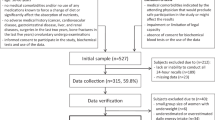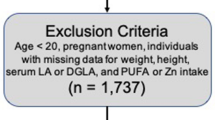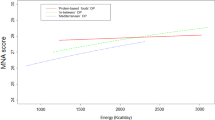Abstract
Background/Objectives:
Evidence supporting the possible effect of dietary factors on adult bone health has emerged in recent decades. The purpose of this study was to ascertain the influence of different dietary patterns on bone mineral density (BMD) among Korean male youth.
Subjects/Methods:
Data were extracted from the Korean National Health and Nutrition Examination Survey (KNHANES) during 2008–2011. The subjects included 1351 male aged 10–25 years. We defined ‘low BMD group’ as subjects with a BMD Z-score of −2.0 or less. Dietary patterns were derived from 20 food groups via factor analysis.
Results:
Three dietary patterns—meat and vegetable, white rice and kimchi, milk-cereal and whole grain—were derived. The ‘milk-cereal and whole-grain’ dietary pattern score showed positive association with energy, protein, fat, calcium, phosphorus, potassium, riboflavin and vitamin C intakes. Participants in the top tertile of the milk-cereal and whole-grain pattern were less likely to have low BMD, compared with subjects in the bottom tertile (odds ratio=0.36, 95% confidence interval=0.16–0.81, P=0.018).
Conclusions:
Our findings suggest that the milk-cereal and whole-grain dietary pattern may have a benign influence on bone health in the Korean male youth.
This is a preview of subscription content, access via your institution
Access options
Subscribe to this journal
Receive 12 print issues and online access
$259.00 per year
only $21.58 per issue
Buy this article
- Purchase on Springer Link
- Instant access to full article PDF
Prices may be subject to local taxes which are calculated during checkout

Similar content being viewed by others
References
Burge R, Dawson-Hughes B, Solomon DH, Wong JB, King A, Tosteson A . Incidence and economic burden of osteoporosis-related fractures in the United States, 2005-2025. J Bone Miner Res 2007; 22: 465–475.
Li SJ, Paik HY, Joung H . Dietary patterns are associated with sexual maturation in Korean children. Br J Nutr 2006; 95: 817–823.
Cooper C, Melton LJ 3rd . Epidemiology of osteoporosis. Trends Endocrinol Metab 1992; 3: 224–229.
Johnston CC, Slemenda CW . Peak bone mass, bone loss and risk of fracture. Osteoporos Int 1994; 4: 43–45.
McGuigan FEA, Murray L, Gallagher A, Davey-Smith G, Neville CE, Van't Hof R et al. Genetic and environmental determinants of peak bone mass in young men and women. J Bone Miner Res 2002; 17: 1273–1279.
Pettifor JM, Prentice A . The role of vitamin D in paediatric bone health. Best Pract Res Clin Endocrinol Metab 2011; 25: 573–584.
Hu FB . Dietary pattern analysis: a new direction in nutritional epidemiology. Curr Opin Lipidol 2002; 13: 3–9.
Kant AK . Dietary patterns and health outcomes. J Am Diet Assoc 2004; 104: 615–635.
Tucker KL . Dietary patterns, approaches, and multicultural perspective. Appl Physiol Nutr Metab 2010; 35: 211–218.
Kontogianni MD, Melistas L, Yannakoulia M, Malagaris L, Panagiotakos DB, Yiannakouris N . Association between dietary patterns and indices of bone mass in a sample of Mediterranean women. Nutrition 2009; 25: 165–171.
Langsetmo L, Poliquin S, Hanley DA, Prior JC, Barr S, Anastassiades T et al. Dietary patterns in Canadian men and women ages 25 and older: relationship to demographics, body mass index, and bone mineral density. BMC Musculoskelet Disord 2010; 11: 20.
Okubo H, Sasaki S, Horiguchi H, Oguma E, Miyamoto K, Hosoi Y et al. Dietary patterns associated with bone mineral density in premenopausal Japanese farmwomen. Am J Clin Nutr 2006; 83: 1185–1192.
Shin S, Joung H . A dairy and fruit dietary pattern is associated with a reduced likelihood of osteoporosis in Korean postmenopausal women. Br J Nutr 2013; 110: 1926–1933.
Tucker KL, Chen HL, Hannan MT, Cupples LA, Wilson PWF, Felson D et al. Bone mineral density and dietary patterns in older adults: the Framingham Osteoporosis Study. Am J Clin Nutr 2002; 76: 245–252.
Hardcastle AC, Aucott L, Fraser WD, Reid DM, Macdonald HM . Dietary patterns, bone resorption and bone mineral density in early post-menopausal Scottish women. Eur J Clin Nutr 2011; 65: 378–385.
Shin S, Hong K, Kang SW, Joung H . A milk and cereal dietary pattern is associated with a reduced likelihood of having a low bone mineral density of the lumbar spine in Korean adolescents. Nutr Res 2013; 33: 59–66.
Whittle CR, Woodside JV, Cardwell CR, McCourt HJ, Young IS, Murray LJ et al. Dietary patterns and bone mineral status in young adults: the Northern Ireland Young Hearts Project. Br J Nutr 2012; 108: 1494–1504.
Wosje KS, Khoury PR, Claytor RP, Copeland KA, Hornung RW, Daniels SR et al. Dietary patterns associated with fat and bone mass in young children. Am J Clin Nutr 2010; 92: 294–303.
Song Y, Park MJ, Paik HY, Joung H . Secular trends in dietary patterns and obesity-related risk factors in Korean adolescents aged 10-19 years. Int J Obes (Lond) 2010; 34: 48–56.
Lee HA, Park H . Correlations between poor micronutrition in family members and potential risk factors for poor diet in children and adolescents using Korean National Health and Nutrition Examination Survey Data. Nutrients 2015; 7: 6346–6361.
Hernandez E, Kim M, Kim WG, Yoon J . Nutritional aspects of night eating and its association with weight status among Korean adolescents. Nutr Res Pract 2016; 10: 448–455.
Butler LM, Wu AH, Wang RW, Koh WP, Yuan JM, Yu MC . A vegetable-fruit-soy dietary pattern protects against breast cancer among postmenopausal Singapore Chinese women. Am J Clin Nutr 2010; 91: 1013–1019.
National Rural Nutrition Institute Food Composition Tables. National Rural Nutrition Institute: Seoul, 2012.
Moon JS, Lee SY, Nam CM, Choi JM, Choe BK, Seo JW et al. 2007 Korean National Growth Charts: review of developmental process and an outlook. Korean J Pediatr 2008; 51: 1–25.
World Health Organization The Asia-Pacific Perspective: Redefining Obesity and Its Treatment. The International Obesity Task Force, Health Communications Australia Pty Ltd: Brisbane, Australia, 2000.
Henry YM, Fatayerji D, Eastell R . Attainment of peak bone mass at the lumbar spine, femoral neck and radius in men and women: relative contributions of bone size and volumetric bone mineral density. Osteoporos Int 2004; 15: 263–273.
Lewiecki EM, Gordon CM, Baim S, Leonard MB, Bishop NJ, Bianchi ML et al. International Society for Clinical Densitometry 2007 Adult and Pediatric Official Positions. Bone 2008; 43: 1115–1121.
Mu M, Wang SF, Sheng J, Zhao Y, Wang GX, Liu KY et al. Dietary patterns are associated with body mass index and bone mineral density in Chinese freshmen. J Am Coll Nutr 2014; 33: 120–128.
Noh HY, Song YJ, Lee JE, Joung H, Park MK, Li SJ et al. Dietary patterns are associated with physical growth among school girls aged 9-11 years. Nutr Res Pract 2011; 5: 569–577.
Mesías M, Seiquer I, Navarro MP . Calcium nutrition in adolescence. Crit Rev Food Sci Nutr 2011; 51: 195–209.
Nicklas TA . Calcium intake trends and health consequences from childhood through adulthood. J Am Coll Nutr 2003; 22: 340–356.
Im JG, Kim SH, Lee GY, Joung H, Park MJ . Inadequate calcium intake is highly prevalent in Korean children and adolescents: the Korea National Health and Nutrition Examination Survey (KNHANES) 2007-2010. Public Health Nutr 2014; 17: 2489–2495.
Herrmann M, Widmann T, Colaianni G, Colucci S, Zallone A, Herrmann W . Increased osteoclast activity in the presence of increased homocysteine concentrations. Clin Chem 2005; 51: 2348–2353.
Dai Z, Koh WP . B-vitamins and bone health—a review of the current evidence. Nutrients 2015; 7: 3322–3346.
Abrahamsen B, Madsen JS, Tofteng CL, Stilgren L, Bladbjerg EM, Kristensen SR et al. Are effects of MTHFR (C677T) genotype on BMD confined to women with low folate and riboflavin intake? Analysis of food records from the Danish osteoporosis prevention study. Bone 2005; 36: 577–583.
Macdonald HM, McGuigan FE, Fraser WD, New SA, Ralston SH, Reid DM . Methylenetetrahydrofolate reductase polymorphism interacts with riboflavin intake to influence bone mineral density. Bone 2004; 35: 957–964.
Yazdanpanah N, Uitterlinden AG, Zillikens MC, Jhamai M, Rivadeneira F, Hofman A et al. Low dietary riboflavin but not folate predicts increased fracture risk in postmenopausal women homozygous for the MTHFR 677T allele. J Bone Miner Res 2008; 23: 86–94.
Ilich JZ, Kerstetter JE . Nutrition in bone health revisited: a story beyond calcium. J Am Coll Nutr 2000; 19: 715–737.
Vicente-Rodriguez G, Ezquerra J, Mesana MI, Fernandez-Alvira JM, Rey-Lopez JP, Casajus JA et al. Independent and combined effect of nutrition and exercise on bone mass development. J Bone Miner Metab 2008; 26: 416–424.
Nelson DA . Peak bone mass. Osteoporosis Int 2000; 11: S47–S48.
Golden NH, Abrams SA, Nutr C . Optimizing bone health in children and adolescents. Pediatrics 2014; 134: E1229–E1243.
Acknowledgements
This research was supported by the Basic Science Research Program through the National Research Foundation of Korea (NRF) funded by the Ministry of Education, Science and Technology (2014R1A6A3A03056928) and was supported by the 2013 Merck Serono research grant. Ministry of Education, Science and Technology and Merck Serono had no role in the design, analysis or writing of this article.
Author information
Authors and Affiliations
Corresponding authors
Ethics declarations
Competing interests
The authors declare no conflict of interest.
Rights and permissions
About this article
Cite this article
Shin, S., Kim, SH., Joung, H. et al. Milk-cereal and whole-grain dietary patterns protect against low bone mineral density among male adolescents and young adults. Eur J Clin Nutr 71, 1101–1107 (2017). https://doi.org/10.1038/ejcn.2017.81
Received:
Revised:
Accepted:
Published:
Issue Date:
DOI: https://doi.org/10.1038/ejcn.2017.81
This article is cited by
-
Adherence to the dietary approaches to stop hypertension and bone health in the Chinese elderly
Journal of Bone and Mineral Metabolism (2023)
-
Bone mineral density and normal-weight obesity syndrome: beyond body weight and body mass index
Journal of Bone and Mineral Metabolism (2023)
-
A meta-analysis of dietary inflammatory index and bone health status
Journal of Diabetes & Metabolic Disorders (2022)
-
Association between dietary inflammatory index and bone density in lactating women at 6 months postpartum: a longitudinal study
BMC Public Health (2019)



